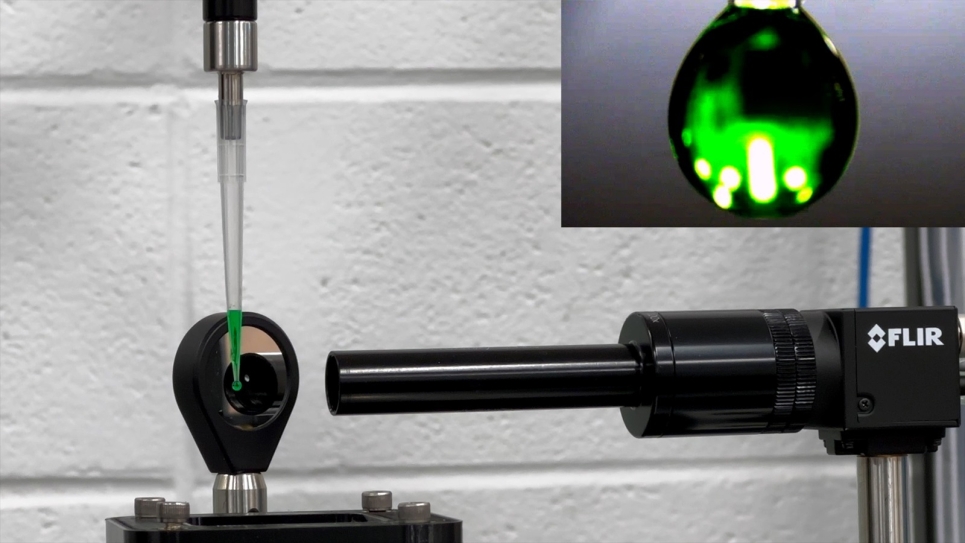
Argonne scientists have developed a new system for X-ray experiments called a robotic pendant drop that will allow them to quickly and easily analyze the structure of liquids without a container. (Image by Argonne National Laboratory.)
The ability to pair the team's innovative method with rigorous simulations on ALCF supercomputers can help researchers to come up with new and more sophisticated experiments.
A small drop of liquid might hold the key to understanding chemical reactions or engineering more effective medicines, but until recently researchers who use X-ray beams to study liquids were limited by time-consuming manual processes and the containers the liquids were held in.
Researchers at the U.S. Department of Energy’s (DOE) Argonne National Laboratory are harnessing the power of artificial intelligence (AI) and robotics to remove barriers to discovery. They’re pioneering a new method to streamline the process of studying the nanoscale structure of liquids without using a container. It’s called a robotic pendant drop, and it works like this:
Researchers have been using X-ray beams to search for the origins of material properties in fluid environments. Typically, studies of liquids have necessitated that the liquid under study be confined in a container. However, using a container usually necessitates human handling and increases the time and number of procedures required for sample exchange. A container also makes it difficult to control the evaporation of the solvent, which is one of the methods for controlling the condition of the sample.
This breakthrough of containerless liquid streamlines the process of exchanging samples between tests so that scientists can study more samples faster.

While this might seem like a small change for studying tiny samples, the implications of this new process could be huge. Because the Advanced Photon Source (APS), a DOE Office of Science user facility at Argonne, is in demand with research projects from all over the world, beamline scientists have limited time on the machine. Every second of research time counts, and this approach could greatly increase productivity at the beamline.
“Traditionally, every time after someone enters the beamline station (hutch) to change the sample and want to close the station for measurement, they’d have to walk over the entire beamline and manually press a series of buttons. This procedure is called ‘searching the hutch’ and the goal is to make sure no one is trapped inside when the X-ray beam is on,” said Argonne robotics engineer Doga Ozgulbas, who was the first author of the study.
Additionally, researchers would need to prepare new samples for testing, load them into liquid containers, and align the samples so that the X-ray beam doesn’t miss the sample. “It’s a very time-consuming and multistep process of unscrewing a container and rescrewing it and then adjusting,” Ozgulbas said.
With the robotic pendant drop, scientists have the ability to change an experiment or perform studies of many different researchers’ samples without the researcher entering the beamline.
Ozgulbas explained that by automating the liquid analysis with the pendant drop, researchers could minimize the time they spend adjusting samples, allowing more available beamtime for experiments. “With the automation tools we are developing, we can lower the frequency at which we need to enter the beamline for sample exchange from once every few hours to potentially once a week or so. This can significantly increase the bandwidth of small teams of researchers as they don’t have to constantly make and change the samples, sometimes late at night, and also frees up the X-ray beam for more research,” he said.
“Essentially, we’re trying to close the loop of material design and characterization through automation,” added Argonne Physicist Qingteng Zhang, a co-corresponding author of the study. “We already have software and data pipelines that allow us to analyze the data in almost real-time, and AI tools that can help us with the interpretation of results. We now want to empower the beamline itself with automated sample exchange and preparation, so that AI can prepare, measure and exchange the sample using robots, look at the results to decide what sample to measure next, and start making the next sample. This will eventually pave the way to autonomous material discovery.”
Argonne computational scientist Arvind Ramanathan, another co-corresponding author of the study, said that challenges experienced during the pandemic helped to motivate this new experimental design. “COVID taught us some lessons, one of which is that it’s good to be nimble enough to execute experiments even if you’re not able to physically access the facilities themselves,” he said. “We’ve given ourselves the ability to run continuously for longer times, which gives us the chance to run new sets of experiments more quickly.”
Combining robotic instrumentation with high performance computing will help to speed up a wide range of experiments, Ramanathan said. “The ability to pair this form of automated discovery with rigorous simulation on the high performance supercomputers at the Argonne Leadership Computing Facility (ALCF) can help researchers to come up with new and more sophisticated experiments,” he said. “These robotic experiments can lead to extremely fast turnaround and accelerate the pace of many studies.” The ALCF is a DOE Office of Science user facility.
“With the APS Upgrade and these new robotic technologies, scientists can do in a few seconds experiments that used to take half a day,” Zhang added. He also mentioned that the next stage of the research involves using a robotic screwdriver to assemble metallic liquid cells for prolonged measurements and precise temperature control. These liquid cells are compatible with viscous liquid or soft solids and have been adopted by many APS users. The robotic cell assembly and exchange will further augment the remote operation mode that was developed during COVID to allow for more versatile experiment design and improve scientific productivity.
A paper based on the study, “Robotic pendant drop: containerless liquid for μs-resolved, AI-executable XPCS,” was published in the Aug. 18, 2023 online edition of Light: Science and Applications.
The research was funded by Argonne’s Laboratory-Directed Research and Development program.